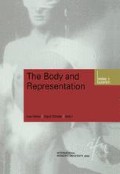Abstract
In 1999, the ‘Society for German language’ together with a group of German journalists and scholars formed a jury in order to select the “one hundred words of the century”. Among these words we find the word ‘schwul’ (which is the German word for gay, but in German it is reserved for men, for male homosexuality), which, according to Volkmar Sigusch, a well known psychotherapist and sexologist, still is a derogatory term that is used to insult homosexual men at the same time as it is a signifier of emancipation (Sigusch, 1999). According to Sigusch, a process of normalisation occurs (for instance, along with current political activities for legal recognition of homosexual partnerships), because “to be normal is the best thing in the world” as he puts it. However, one might ask why the jury did not also choose the word for female homosexuality, ‘lesbisch’ (lesbian). Sigusch suggests that the gay movement is a movement dominated by men and that therefore the jury could not find an adequate and comparable term that would point to a lesbian movement. He claims that lesbian women continue to remain in a state of subversion and stubbornness. Sigusch uses the terms ‘lesbian’ and ‘lesbian movement’, but does not want to see them as representative terms. This little anecdote of a performative contradiction shows that there is still a specific problem with lesbian representation that seems to impact on the mode of representation itself, which appears to be hybrid and unstable.
Access this chapter
Tax calculation will be finalised at checkout
Purchases are for personal use only
Preview
Unable to display preview. Download preview PDF.
Literature
Allen, J. (Ed.) (1990). Lesbian philosophies and cultures. Albany, New York: State University of New York Press 1990.
Butler, J. (1990). Gender trouble. New York: Routledge.
Case, S. (1989). Toward a butch-femme aesthetic. In L. Hart (Ed.), Making a spectacle. Feminist essays in contemporary women’s theatre (pp. 282–299). Ann Arbor: (Mich. ): University of Michigan Press.
Doan, L. (Ed.) (1994). The lesbian postmodern. New York: Columbia University Press.
Duc, A. (i.e. Minna Wettstein-Adelt) (1976). Sind es Frauen? Roman über das dritte Geschlecht. Berlin: Amazonen Frauenverlag. (Original work published 1901 ).
Ellis, H. (1924). Sexual inversion, Studies in the Psychology of Sex, Vol. 2. Philadelphia/Pa.: Davis.
Ellis, H. (1936). Studies in the psychology of sex. New York: Random House.
Foucault, M. (1993). Sexualität und Wahrheit: Der Wille zum Wissen (Vol. 1 ). Frankfurt/M.: Suhrkamp.
Glasgow, J. (1997). Rethinking the mythic mannish Radclyffe Hall. In M. Duberman (Ed.), Queer representations. Reading lives, reading cultures (pp. 197–208 ). New York: New York University Press.
Hall, R. (1982). The well of loneliness. London: Virago.
Hark, S. (Ed.) (1996). Grenzen lesbischer Identitäten. Berlin: Querverlag.
Hirschfeld, M. (1948). Sexual anomalies: The origins, nature, and treatment of sexual disorders. New York: Emerson Books.
King, K. (1986). The situation of lesbianism as feminism’s magical sign: Contest for meaning and the U.S. women’s movement 1968–1972. Communications, Vol. 9, pp. 65–91.
Krafft-Ebing, R. von (1965). Psychopathia sexualis. New York: Stein and Day.
MacPike. L. (1997). Is Mary Llewellyn an invert? In: Elizabeth Jane Harrison (Ed.), Unmanning modernism–gendered re-readings (pp. 73–89 ). Knoxville: University of Tennessee Press.
Munt, S. (Ed.) (1992). New lesbian criticism. Literary and cultural readings. New York, London: Harvester Wheatsheaf.
Nestle, J. (1987). A restricted country. Ithaca: New York: Firebrand Books.
Nestle, J. (Ed.) (1992). The persistent desire. A Femme-Butch-Reader. Boston: Alyson Publications.
Newton, E. (1984). The mythic mannish lesbian: Radclyffe Hall and the New Woman. Signs. Journal of Women in Culture and Society, Vol. 9, no. 4, pp. 557–575.
Ruehl, S. (1985). Inverts and experts: Radclyffe Hall and the lesbian identity. In Judith Lowder Newton (Ed.), Feminist criticism and social change. Sex, class, and race in literature and culture (pp. 165–180 ). New York: Methuen.
Schmersahl, K. (1998). Medizin und Geschlecht: zur Konstruktion der Kategorie Geschlecht im medizinischen Diskurs des 19. Jahrhunderts. Opladen: Leske und Budrich.
Sigusch, V. ( 1999, December 13). 100 Wörter des Jahrhunderts: Schwul. Süddeutsche Zeitung.
Wittig, M. (1973). Le corps lesbien. Paris: Les Editions de Minuit (engl.: The lesbian body, transi. by David Le Vay, Boston 1986 ).
Wittig, M. (1979). Paradigm. In G. Stambolian and E. Marks (Eds.), Homosexualities and French literature. Cultural contexts/critical texts (pp. 114–121 ). Ithaca: Cornell University Press.
Wittig, M. (Winter, 1981 ). One is not born a woman. Feminist Issues, Vol. 1, no. 2, pp. 47–54.
Wittig, M. (1986). The mark of gender. In N. K. Miller (Ed.), The poetics of gender (pp. 6373 ). New York: Columbia University Press.
Wolfe, S. J. and Penelope, J. (Eds.) (1993). Sexual practice/textual theory: Lesbian cultural criticism. Cambridge (Mass.), Oxford: Blackwell.
Editor information
Editors and Affiliations
Rights and permissions
Copyright information
© 2002 Springer Fachmedien Wiesbaden
About this chapter
Cite this chapter
Funk, J. (2002). The Lesbian Body — a Monstrous or a Transcendental Signifier?. In: Härtel, I., Schade, S. (eds) Body and Representation. Schriftenreihe der Internationalen Frauenuniversität »Technik und Kultur«, vol 6. VS Verlag für Sozialwissenschaften, Wiesbaden. https://doi.org/10.1007/978-3-663-11622-6_4
Download citation
DOI: https://doi.org/10.1007/978-3-663-11622-6_4
Publisher Name: VS Verlag für Sozialwissenschaften, Wiesbaden
Print ISBN: 978-3-8100-3254-6
Online ISBN: 978-3-663-11622-6
eBook Packages: Springer Book Archive

